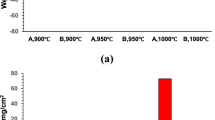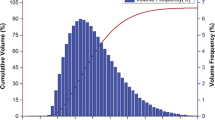Abstract
The resistance to surface degradation in metallic alloys plays an important role for the lifetime of the components working in harsh environments. The mechanisms involved in degradation of metallic surface in a high-temperature aggressive gaseous atmosphere include the following: forming adherent to the surface multiphase oxide layer, partial spallation, and possible vaporization of formed compounds. The governing equation, which describes a parabolic growth of adherent layer, time-dependent vaporization, and cross-linked to instantaneous thickness of adherent layer spallation rate, was suggested and analyzed. The several relationships between the kinetic constants were defined from analysis of the governing equation. Design of routes for experimental procedures to determine the independent kinetic constants was discussed and an integrated simulator was used to calculate the kinetic constants based on experimental results. Two examples of high-temperature oxidation of heat-resistant Cr/Ni austenitic steel were used to illustrate the capability of the suggested method to determine the oxidation, spallation, and vaporization kinetic constants from a single experiment. The suggested methodology could be considered in future for the analysis of different types of surface degradation of solid materials in gaseous, liquid, or solid environments.











Similar content being viewed by others
References
R. Jojith, M. Sam, and N. Radhika: Eng. Sci. Technol. Int. J., 2022, vol. 25, pp. 1–7.
A. Khan, A. Qurashi, W. Badeghaish, M. Noui-Mehidi, and M. Aziz: Sensors (Basel), 2020, vol. 20, p. 6583.
E. Stansbury and R. Buchanan: Fundamentals of Electrochemical Corrosion, ASM International, Materials Park, 2020.
G. Xu, K. Wang, X. Dong, L. Yang, M. Ebrahimi, H. Jiang, Q. Wang, and W. Ding: J. Mater. Sci. Technol. Technol., 2021, vol. 71, pp. 12–22.
L. Ma, C. Zhang, Y. Wu, and I. Yuanwei: Sol. Energy Mater. Sol. Cell, 2022, vol. 234, p. 111485.
R. Chen and W. Yeun: Oxid. Met., 2003, vol. 59, pp. 433–68.
C. Taylor and B. Tossey: Mater. Degrad., 2021, vol. 5, p. 38.
H.E. Evans: Int. Mater. Rev., 1995, vol. 40, pp. 1–40.
R. Pillai, A. Chyrkin, and W. Quadakkers: Oxid. Met., 2021, vol. 96, pp. 385–436.
H. Asteman, J. Svensson, and L. Johansson: J. Electrochem. Soc., 2004, vol. 15, p. B141.
M. Romedenne, R. Pillai, S. Dryepondt, and B. Pint: Oxid. Met., 2021, vol. 96, pp. 589–612.
D. Young and B. Pint: Oxid. Met., 2006, vol. 66, pp. 137–53.
C. Taylor: Corros. Eng. Sci. Technol., 2015, vol. 50, pp. 490–508.
S. Bigdeli, L. Kjellqvist, R. Naraghi, L. Hoglund, H. Larsson, and T. Jonsson: J. Phase Equilib. Diffus., 2021, vol. 42, pp. 403–18.
W. Blades, E. Opila, and K. Sieradzki: J. Electrochem. Soc., 2022, vol. 169, p. 061501.
H. Mehrer and G. Murch: Diffus. Found., 2021, vol. 29, pp. 1–30.
R. Osei, S. Lekakh, and R. O’Malley: Metall. Mater. Trans. B, 2021, vol. 52B, pp. 393–404.
J. Philibert: Solid State Ion., 1999, vol. 117, pp. 1–7.
O. Kubaschewski and B.E. Hopkins: Oxidation of Metals and Alloys, Butterworths, London, 1962.
V. Rosenband, A. Gany, and Y. Timnat: Oxid. Met., 1995, vol. 43, pp. 141–56.
H. Evans, G. Mitchell, R. Lobb, and D. Owen: Proc. R. Soc. Lon. A, 1993, vol. 440, pp. 1–22.
R. Pillai, M. Romedenne, J. Peng, B. Pint, J.J. Haynes, G. Muralidharan, and D. Shin: Oxid. Met., 2022, vol. 97, pp. 51–76.
R. Auguste, R. Chan, and E. Romanovskaia: Mater. Degrad., 2022, vol. 6, p. 61.
T. Sand, C. Geers, Y. Cao, J. Svensson, and L. Johansson: Oxid. Met., 2019, vol. 92, pp. 259–79.
C. Tedmon: J. Electrochem. Soc., 1966, vol. 113, pp. 766–69.
C. Lowell, C. Barrett, R. Palmer, J. Auping, and H. Probst: Oxid. Met., 1991, vol. 36, pp. 81–112.
R. Duan, A. Jalowicka, K. Unocic, B. Pint, P. Huczkowski, A. Chyrkin, D. Grüner, R. Pillai, and W. Quadakkers: Oxid. Met., 2017, vol. 87, pp. 11–38.
D. Poquillon and D. Monceau: Oxid. Met., 2003, vol. 59, pp. 409–31.
S. Lekakh, O. Neroslavsky, M. Li, and L. Godlevski: Oxid. Met., 2022, vol. 98, pp. 239–54.
B. Pujilaksono, T. Jonsson, M. Halvarsson, I. Panas, J. Svensson, and L. Johansson: Oxid. Met., 2008, vol. 70, pp. 163–88.
J. Smialek: High Temp. Corros. Mater., 2023, vol. 99, pp. 431–57.
S. Sureau, D. Poquillon, and D. Monceau: Scr. Mater., 2007, vol. 56, pp. 233–36.
S. Lekakh, O. Neroslavsky, M. Li, and L. Godlevski: High Temp. Corros. Mater., 2023, vol. 99, pp. 79–99.
S. Lekakh, M. Buchely, M. Li, and L. Godlevski: Mater. Sci. Eng. A, 2023, vol. 873, p. 145027.
R. Rapp: Metall. Trans. A, 1984, vol. 15A, pp. 765–82.
Y. Chen, T. Tan, and H. Chen: J. Nucl. Sci. Technol., 2008, vol. 45, pp. 662–67.
N. Jacobson, M. Kuczmarski, and B. Kowalski: Oxid. Met., 2020, vol. 93, pp. 247–82.
Acknowledgments
Authors appreciate the support provided by Ford Motor and Missouri University of Science and Technology
Author information
Authors and Affiliations
Corresponding author
Ethics declarations
Conflict of interest
On behalf of all authors, the corresponding author states that there is no conflict of interest.
Additional information
Publisher's Note
Springer Nature remains neutral with regard to jurisdictional claims in published maps and institutional affiliations.
Appendix
Appendix
-
A1
The solution of the differential Eq. [6], under assumption X(0) = 0, links process time (τ, h) to the thickness of the oxidized adherent layer (X, cm) for the given set of kinetic coefficients for oxidation KP (cm2/h), for vaporization KV (cm/h), and for spallation KS (1/h):
$$ \tau = \frac{{K_{\text{V}} - G}}{{2K_{\text{S}} G}}ln\left( {\frac{{2K_{\text{S}} X + K_{\text{V}} - G}}{{K_{\text{V}} - G}}} \right) - \frac{{K_{\text{V}} + G}}{{2K_{\text{S}} G}}ln\left( {\frac{{2K_{\text{S}} X + K_{\text{V}} + G}}{{K_{\text{V}} + G}}} \right) $$(A1)where: \(G = \sqrt {K_{\text{V}}^{2} + 2K_{\text{S}} K_{p} }\)
-
A2
When solid reaction product is determined at the test end (τf), including the weight of specimen with adherent oxide (ΔWf), the weight of spalled oxide (\({\Delta W}_{f}^{s}\)), and the final thickness of adherent scale (Xf), the vaporization constant (KV) could be calculated from a final mass balance, assuming that the metal oxide density (ρox), and the weight fraction of oxygen-in oxide (fO) are known:
$$ K_{\text{V}} = \frac{{f_{o} X_{f} }}{{\left( {1 - f_{o} } \right)\tau_{f} }} - \frac{{\Delta W_{f}^{s} }}{{\rho_{\text{ox}} \tau_{f} }} - \frac{{\Delta W_{f} }}{{\rho_{\text{ox}} \tau_{f} \left( {1 - f_{o} } \right)}} $$(A2) -
A3
When all three mechanisms were involved, we have KV > 0, KS > 0 and for any intermediate experimental time (τi), instant thickness Xi of adherent layer can be analytically calculated for a known weight of specimen (ΔWi) and a weight of spalled (\({W}_{i}^{s}\)) scale:
$$ X_{i} = \frac{{\Delta W_{i} }}{{\rho _{{ox}} f_{o} }} + \frac{{K_{\text{V}} \left( {1 - f_{o} } \right)\tau _{i} }}{{f_{o} }} + \frac{{W_{i}^{s} (1 - f_{o} )}}{{\rho _{{ox}} f_{o} }} $$(A3) -
A4
When only specimen weight was monitored in experiments, the characteristic point of a maximal weight of specimen with adherent layer can be used for indirect analysis of surface degradation mechanisms. For the three processes described in Eq. [6], the thickness of adherent layer (Xm) at a time (τm) when weight change of specimen with adherent layer achieved maximum (ΔWm) can be found:
$$ \begin{aligned} \tau_{\text{m}} & = \frac{{K_{\text{V}} - G}}{{2K_{\text{S}} G}}\ln \left( {\frac{{G_{f} - G}}{{K_{\text{V}} - G}}} \right) - \frac{{K_{\text{V}} + G}}{{2K_{\text{S}} G}}\ln \left( {\frac{{G_{f} + G}}{{K_{\text{V}} + G}}} \right) \hfill \\ X_{\text{m}} & = \frac{{G_{f } - K_{\text{V}} }}{{2K_{\text{S}} }} \hfill \\ \end{aligned} $$(A4)where \(G = \sqrt {K_{\text{V}}^{2} + 2K_{\text{S}} K_{p} } \;{\text{and}}\;G_{f} = \sqrt {K_{\text{V}}^{2} + 2K_{\text{S}} K_{p} f_{\text{O}} }.\)
Rights and permissions
Springer Nature or its licensor (e.g. a society or other partner) holds exclusive rights to this article under a publishing agreement with the author(s) or other rightsholder(s); author self-archiving of the accepted manuscript version of this article is solely governed by the terms of such publishing agreement and applicable law.
About this article
Cite this article
Lekakh, S.N., Neroslavsky, O. Phenomenological Analysis of Surface Degradation of Metallic Materials in Extreme Environment. Metall Mater Trans A 55, 134–143 (2024). https://doi.org/10.1007/s11661-023-07234-2
Received:
Accepted:
Published:
Issue Date:
DOI: https://doi.org/10.1007/s11661-023-07234-2




